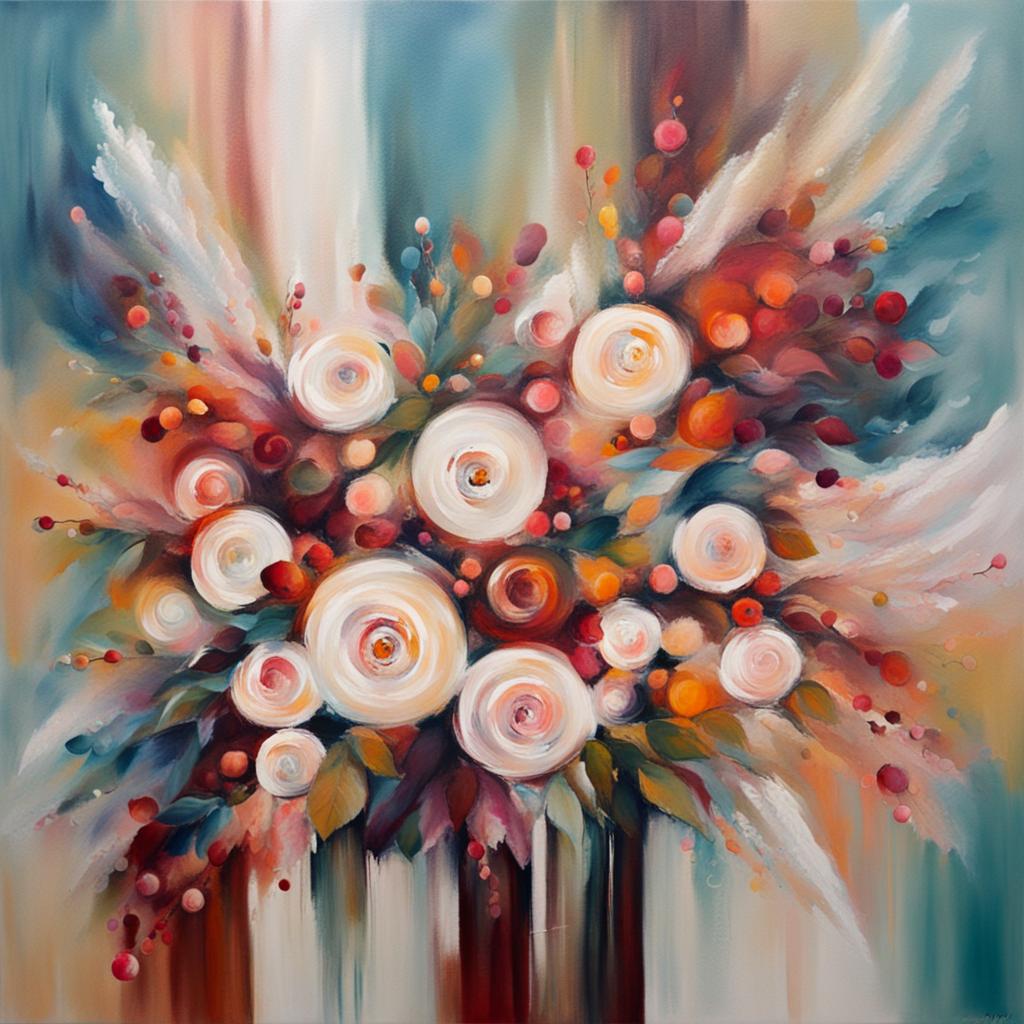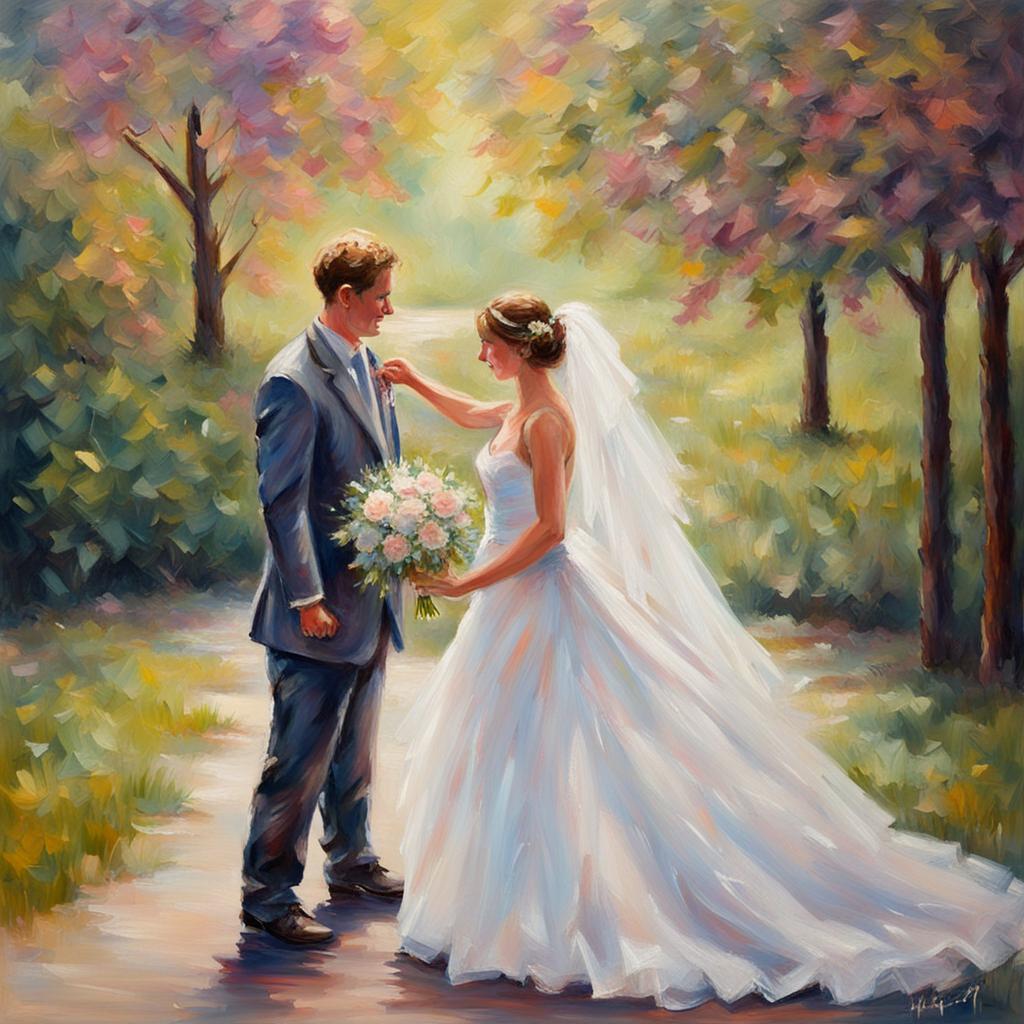Find an artist whose vibe matches what you’re envisioning for your wedding painting. If you go for an abstract painter and want a realistic look, chances are you might not get the result you’re hoping for. Make sure the artist’s style aligns with the kind of feel you want for your big day!
Here are some examples of different art styles and how they might look applied to wedding paintings. You can blame any weirdness on being AI-generated images.

Abstract Art:
An abstract approach to wedding painting could involve using shapes, colors, and forms to capture the emotions, energy, and essence of the wedding day rather than focusing on realistic depictions. This style might allow the artist to convey the joy, love, and vibrancy of the occasion through a more subjective and interpretive lens.

Impressionism:
Impressionist wedding paintings might emphasize the fleeting moments and atmospheric conditions of the celebration. Loose brushstrokes and a focus on light and color could be employed to convey the immediate impressions and emotions of the event. The result might be a painting that captures the overall ambiance and mood of the wedding.

Realism:
Realist wedding paintings would aim to depict the event with a high degree of accuracy and attention to detail. The artist might focus on capturing the specific elements of the ceremony, venue, and people involved in a true-to-life manner. This style would provide a more traditional and faithful representation of the wedding.

Plein Air:
A plein air approach to wedding painting involves creating art on-site, directly capturing the outdoor scenes and natural light of the wedding location. This could result in a more spontaneous and authentic representation of the ceremony and reception, with the artist responding to the changing conditions and atmosphere.

Surrealism:
Surrealist wedding paintings might introduce dreamlike or fantastical elements, exploring the subconscious aspects of the couple’s connection. This style could involve symbolic representations, unexpected juxtapositions, or imaginative scenes to convey the deeper, emotional layers of the relationship.

Cubism:
Cubist wedding paintings could involve breaking down the various elements of the wedding into geometric shapes and presenting multiple viewpoints simultaneously. This style might capture different facets of the celebration from various angles, providing a unique and multidimensional representation of the event.

Pop Art:
Pop Art wedding paintings might incorporate iconic symbols, colors, and imagery associated with weddings and popular culture. The style could add a contemporary and vibrant twist to the traditional wedding scene, celebrating the couple and the cultural elements of their union.

Expressionism:
Expressionist wedding paintings might focus on conveying the emotional intensity and subjective experiences of the couple. Bold colors, distorted forms, and expressive brushstrokes could be used to emphasize the feelings and connections between the individuals involved.

Minimalism:
Minimalist wedding paintings would strip away excess details, focusing on essential elements and creating a simplified, elegant representation of the ceremony. Clean lines, neutral colors, and a deliberate lack of ornamentation might highlight the purity and significance of the moment.

Baroque:
Baroque-inspired wedding paintings might incorporate grandeur, drama, and ornate details to elevate the significance of the celebration. This style could involve dynamic compositions, elaborate costumes, and a sense of opulence, reflecting the importance and splendor of the wedding event.

Fauvism:
Fauvist wedding paintings feature bold and vibrant colors, departing from realistic representations to emphasize the emotional impact of the celebration. The style might convey the joyful and lively atmosphere of the wedding through non-naturalistic hues and energetic brushstrokes.

Rococo:
Rococo wedding paintings could embrace ornate and playful aesthetics, depicting the romance, love, and elegance associated with weddings. Delicate details, pastel colors, and a sense of gracefulness might characterize the portrayal of the couple and the event.

Gothic:
Gothic-inspired wedding paintings might draw on the architectural elements of Gothic art to create a sense of timelessness and solemnity. The use of pointed arches, intricate details, and spiritual symbolism could add a sense of grandeur and reverence to the depiction of the ceremony.

Neo-Classicism:
Neo-Classical wedding paintings would adopt classical ideals of beauty and form, focusing on clarity, order, and nobility. The style might convey a sense of timelessness and eternal love, with the couple depicted in a dignified and idealized manner reminiscent of classical art.
